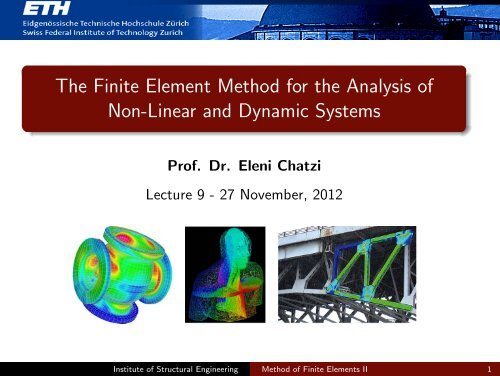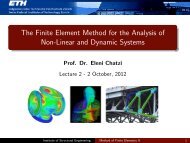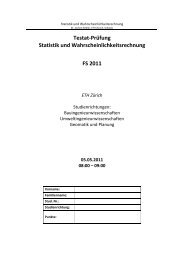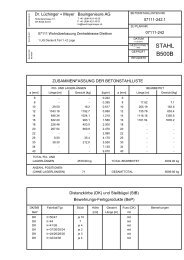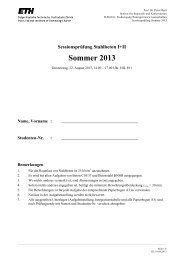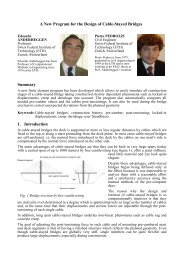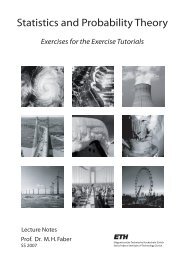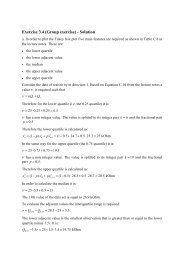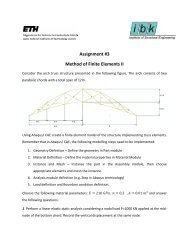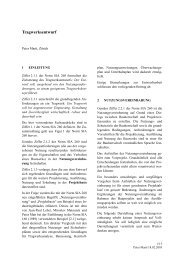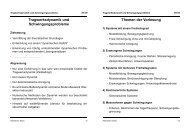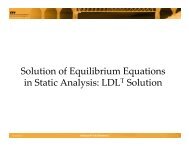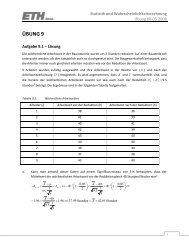The Finite Element Method for the Analysis of Non-Linear and ...
The Finite Element Method for the Analysis of Non-Linear and ...
The Finite Element Method for the Analysis of Non-Linear and ...
You also want an ePaper? Increase the reach of your titles
YUMPU automatically turns print PDFs into web optimized ePapers that Google loves.
<strong>The</strong> <strong>Finite</strong> <strong>Element</strong> <strong>Method</strong> <strong>for</strong> <strong>the</strong> <strong>Analysis</strong> <strong>of</strong><br />
<strong>Non</strong>-<strong>Linear</strong> <strong>and</strong> Dynamic Systems<br />
Pr<strong>of</strong>. Dr. Eleni Chatzi<br />
Lecture 9 - 27 November, 2012<br />
Institute <strong>of</strong> Structural Engineering <strong>Method</strong> <strong>of</strong> <strong>Finite</strong> <strong>Element</strong>s II 1
State Space Equation Formulation<br />
2d<strong>of</strong> Mass Spring System<br />
k 1<br />
c 1<br />
m 1<br />
( t 1 )<br />
x 1 ( t )<br />
F k<br />
2<br />
m<br />
2<br />
c 1<br />
F ( t 2 )<br />
x 2 ( t )<br />
FBD<br />
k1x1<br />
cx<br />
1 1<br />
m 1<br />
( t 1 )<br />
k<br />
( x2 − x1)<br />
k2( x2 − x1)<br />
2<br />
m<br />
2<br />
F<br />
c2( x2 − x1)<br />
c2( x2 − x1)<br />
(Lumped Mass System)<br />
F ( t 2 )<br />
We introduce <strong>the</strong> augmented state vector:<br />
x = [ x 1 x 2 ẋ 1 ẋ 2<br />
] T (controllable <strong>for</strong>m equivalent). <strong>The</strong>n,<br />
ẋ =<br />
⎡<br />
⎢<br />
⎣<br />
⎤<br />
0 0 1 0<br />
0 0 0 1<br />
[<br />
−m −1 k ] [ −m −1 c ] ⎥<br />
⎦<br />
⎡ ⎤ ⎡<br />
x 1<br />
⎢ x 2<br />
⎥<br />
⎣ ẋ 1<br />
⎦ + ⎢<br />
⎣<br />
ẋ 2<br />
⎤<br />
0 0<br />
0 0<br />
[<br />
m<br />
−1 ] ⎥<br />
⎦<br />
[<br />
F1<br />
F 2<br />
]<br />
Institute <strong>of</strong> Structural Engineering <strong>Method</strong> <strong>of</strong> <strong>Finite</strong> <strong>Element</strong>s II 2
State Space Equation Formulation<br />
2d<strong>of</strong> Mass Spring System<br />
where u = [ F 1<br />
F 2<br />
] T<br />
⇒ ẋ = Ax + Bu<br />
Assume you would like to monitor <strong>the</strong> displacement x 1 , x 2 . <strong>The</strong>n<br />
<strong>the</strong> “observation vector” is:<br />
y =<br />
⎡<br />
⎢<br />
⎣<br />
1 0 0 0<br />
0 1 0 0<br />
0 0 0 0<br />
0 0 0 0<br />
⎤ ⎡<br />
⎥ ⎢<br />
⎦ ⎣<br />
⎤<br />
x 1<br />
x 2<br />
x 3<br />
x 4<br />
⎥<br />
⎦ + O 4×2 u(t)<br />
⇒ y = Cx + Du<br />
Institute <strong>of</strong> Structural Engineering <strong>Method</strong> <strong>of</strong> <strong>Finite</strong> <strong>Element</strong>s II 3
State Space Equation Formulation<br />
Using <strong>the</strong> state space representation we have converted a 2nd order ODE<br />
into an equivalent 1st order ODE system. We can now use any 1st order<br />
ODE integration method to convert <strong>the</strong> continuous system into a<br />
discrete one <strong>and</strong> obtain an approximate solution:<br />
1st order ODE Integration <strong>Method</strong>s<br />
Assume dy<br />
dt = f(t, y(t)), y(t 0) = 0<br />
Forward Euler <strong>Method</strong><br />
y n+1 = y n + hf(t n , y n )<br />
where h is <strong>the</strong> integration time step. This explicit expression is<br />
obtained from <strong>the</strong> truncated Taylor Expansion <strong>of</strong> y(t n + h)<br />
Backward Euler <strong>Method</strong><br />
y n+1 = y n + hf(t n+1, y n+1 )<br />
This implicit expression (since y n+1 is on <strong>the</strong> right h<strong>and</strong> side) is<br />
obtained from <strong>the</strong> truncated Taylor Expansion <strong>of</strong> y(t n+1 − h)<br />
Institute <strong>of</strong> Structural Engineering <strong>Method</strong> <strong>of</strong> <strong>Finite</strong> <strong>Element</strong>s II 4
State Space Equation Formulation<br />
2nd Order Runge Kutta (RK2)<br />
k 1 = hf(t n , y n ), k 2 = hf(t n + 1 2 h, y n + 1 2 k 1)<br />
y n+1 = y n + k 2 + O(h 3 )<br />
4th Order Runge Kutta (RK4)<br />
k 1 = hf(t n , y n ), k 2 = hf(t n + 1 2 h, y n + 1 2 k 1)<br />
k 3 = hf(t n + 1 2 h, y n + 1 2 k 2), k 4 = hf(t n + h, y n + k 3 )<br />
y n+1 = y n + 1 6 k 1 + 1 3 k 2 + 1 3 k 3 + 1 6 k 4 + O(h 5 )<br />
Institute <strong>of</strong> Structural Engineering <strong>Method</strong> <strong>of</strong> <strong>Finite</strong> <strong>Element</strong>s II 5
Mode Superposition <strong>Method</strong><br />
Direct Integration <strong>Method</strong>s<br />
Assuming diagonal mass matrix <strong>and</strong> no damping, implicit methods<br />
require on average 2nm k calculations per time step<br />
where n is <strong>the</strong> <strong>the</strong> dimension <strong>of</strong> <strong>the</strong> stiffness matrix <strong>and</strong> m k <strong>the</strong><br />
half-b<strong>and</strong>width<br />
<strong>The</strong> central difference method (explicit scheme) requires significantly<br />
fewer operations per time step however has o<strong>the</strong>r drawbacks (requires<br />
T < T cr ⇒ more time steps!)<br />
<strong>The</strong> total number <strong>of</strong> operations in a Direct Integration <strong>Method</strong> are<br />
directly proportional to <strong>the</strong> number <strong>of</strong> load steps ⇒ only effective <strong>for</strong><br />
short durations (small number <strong>of</strong> time steps)<br />
Mode Superposition <strong>Method</strong>s<br />
<strong>The</strong>se methods work by trans<strong>for</strong>ming <strong>the</strong> equilibrium equations into a<br />
<strong>for</strong>m in which step by step solution is less costly<br />
In particular we aim at a reduction <strong>of</strong> m k which would proportionally<br />
decrease <strong>the</strong> step by step solution<br />
Institute <strong>of</strong> Structural Engineering <strong>Method</strong> <strong>of</strong> <strong>Finite</strong> <strong>Element</strong>s II 6
Mode Superposition <strong>Method</strong><br />
Equilibrium Equations Trans<strong>for</strong>mation - Change <strong>of</strong> Basis<br />
<strong>The</strong> following trans<strong>for</strong>mation is used on <strong>the</strong> n finite element nodal<br />
point displacements U:<br />
U(t) = PX(t)<br />
where P is an n × n square matrix <strong>and</strong> X(t) is <strong>the</strong> “generalized<br />
displacement” vector (time dependent)<br />
<strong>The</strong> dynamic equation <strong>of</strong> motion <strong>the</strong>n can be written as:<br />
˜MẌ(t) + ˜CẊ(t) + ˜KX(t) = ˜R(t)<br />
where ˜M = P T MP ˜C = P T CP ˜K = P T KP ˜R = P T R<br />
are <strong>the</strong> trans<strong>for</strong>med matrices corresponding to a smaller b<strong>and</strong>width<br />
than <strong>the</strong> original system.<br />
Institute <strong>of</strong> Structural Engineering <strong>Method</strong> <strong>of</strong> <strong>Finite</strong> <strong>Element</strong>s II 7
Mode Superposition <strong>Method</strong><br />
Choice <strong>of</strong> Trans<strong>for</strong>mation Matrix P<br />
P is established using <strong>the</strong> displacement solution <strong>for</strong> Undamped, Free<br />
vibrations:<br />
MÜ + KU = 0 (1)<br />
<strong>The</strong> solution <strong>of</strong> this 2nd Order ODE is <strong>of</strong> <strong>the</strong> <strong>for</strong>m:<br />
U = φsinω(t − t 0 )<br />
where φ is a vector <strong>of</strong> order n, t is <strong>the</strong> time variable, t 0 is a time<br />
constant corresponding to <strong>the</strong> phase <strong>and</strong> ω is <strong>the</strong> vibration frequency<br />
<strong>of</strong> vector φ, <strong>the</strong>n<br />
Ü = −ω 2 φsinω(t − t 0 )<br />
<strong>and</strong> (1) becomes:<br />
−ω 2 Mφ + Kφ = 0 (eigenproblem)<br />
Institute <strong>of</strong> Structural Engineering <strong>Method</strong> <strong>of</strong> <strong>Finite</strong> <strong>Element</strong>s II 8
Mode Superposition <strong>Method</strong><br />
Matrix Form<br />
Defining a matrix Φ whose columns are <strong>the</strong> eigenvectors φ i <strong>and</strong> a<br />
diagonal matrixΩ 2 which stores <strong>the</strong> eigenvalues ωi 2 on its diagonal,<br />
i.e:<br />
⎡<br />
⎤<br />
ω 1<br />
Φ = [ ]<br />
φ 1 , φ 2 , ... φ n ; Ω 2 = ⎢ ω 2 ⎥<br />
⎣ ... ⎦ ;<br />
ω n<br />
we can write <strong>the</strong> n solutions to <strong>the</strong> eigenproblem as:<br />
MΦΩ 2 = KΦ<br />
Institute <strong>of</strong> Structural Engineering <strong>Method</strong> <strong>of</strong> <strong>Finite</strong> <strong>Element</strong>s II 9
Properties <strong>of</strong> Eigenvectors<br />
Solution <strong>of</strong> <strong>the</strong> Eigenproblem<br />
−ω 2 Mφ + Kφ = 0<br />
(eigenproblem)<br />
<strong>The</strong> above homogeneous linear system <strong>of</strong> equations can only have a<br />
solution if <strong>the</strong> determinant is equal to 0:<br />
∥<br />
∥−ω 2 M + K ∥ ∥ = 0<br />
<strong>The</strong> solution <strong>of</strong> <strong>the</strong> above equation will yield:<br />
n eigenvalues ωi 2,<br />
i = 1, ..., n<br />
with 0 ≤ ω 1 ≤ ...ω n (<strong>the</strong> eigenfrequencies) <strong>and</strong><br />
<strong>The</strong> solution <strong>of</strong> ω 2 Mφ = Kφ (eigenproblem) will yield:<br />
n eigenvectors (or modal vectors) φ i<br />
Institute <strong>of</strong> Structural Engineering <strong>Method</strong> <strong>of</strong> <strong>Finite</strong> <strong>Element</strong>s II 10
Properties <strong>of</strong> Eigenvectors<br />
M-Orthonormality<br />
From Matrix Properties we know that (AB) T = B T A T ,<br />
Thus, <strong>for</strong> two eigenvectors φ n , φ r we obtain:<br />
(φ T nKφ r ) T = φ T rK T φ n<br />
Since <strong>the</strong> Stiffness matrix is symmetric, K = K T , hence<br />
(φ T nKφ r ) T = φ T rKφ n<br />
<strong>The</strong> same applies <strong>for</strong> <strong>the</strong> Mass matrix, M = M T , yielding:<br />
(φ T nMφ r ) T = φ T rMφ n<br />
Institute <strong>of</strong> Structural Engineering <strong>Method</strong> <strong>of</strong> <strong>Finite</strong> <strong>Element</strong>s II 11
Properties <strong>of</strong> Eigenvectors<br />
M-Orthonormality<br />
<strong>The</strong> eigenproblem <strong>for</strong> vector n <strong>the</strong>n can be written as:<br />
ωrφ 2 T nMφ r = φ T transpose<br />
nKφ r −→<br />
ω 2 rφ T rMφ n = φ T rKφ n<br />
<strong>and</strong> <strong>the</strong> eigenproblem <strong>for</strong> vector n is: <strong>The</strong> eigenproblem <strong>for</strong> vector n<br />
<strong>the</strong>n can be written as:<br />
ω 2 nφ T rMφ n = φ T rKφ n<br />
By subtracting <strong>the</strong> two previous <strong>for</strong>mulas we obtain:<br />
(ω 2 r − ω 2 n)φ T rMφ n = 0<br />
We conclude that <strong>for</strong> n ≠ r ⇒ φ T rMφ n = 0, φ T rMφ n = 0,<br />
Institute <strong>of</strong> Structural Engineering <strong>Method</strong> <strong>of</strong> <strong>Finite</strong> <strong>Element</strong>s II 12
Properties <strong>of</strong> Eigenvectors<br />
M-Orthonormality<br />
We choose φ n , such that:<br />
Φ T MΦ = I<br />
<strong>the</strong>re<strong>for</strong>e from MΦΩ 2 = KΦ we have that:<br />
Φ T KΦ = Ω 2<br />
<strong>The</strong> principle <strong>of</strong> M-orthonormality can <strong>the</strong>n be written as:<br />
{ 1, n = r<br />
φ T rMφ n =<br />
0, n ≠ r<br />
{ ω<br />
2<br />
φ T rKφ n = n , n = r<br />
0, n ≠ r<br />
Institute <strong>of</strong> Structural Engineering <strong>Method</strong> <strong>of</strong> <strong>Finite</strong> <strong>Element</strong>s II 13
Mode Superposition <strong>Method</strong><br />
It is now obvious that we can use Φ as <strong>the</strong> trans<strong>for</strong>mation matrix P.<br />
Using:<br />
U(t) = ΦX(t)<br />
we obtain <strong>the</strong> trans<strong>for</strong>med equilibrium equation:<br />
Ẍ(t) + Φ T CΦẊ(t) + Ω 2 X(t) = Φ T R(t)<br />
where using <strong>the</strong> property <strong>of</strong> M-orthonormality, <strong>the</strong> initial conditions<br />
will be:<br />
0 X = Φ T M 0 U;<br />
0 Ẋ = Φ T M 0 ˙U<br />
Institute <strong>of</strong> Structural Engineering <strong>Method</strong> <strong>of</strong> <strong>Finite</strong> <strong>Element</strong>s II 14
Dynamic Response with Damping Neglected<br />
If we neglect <strong>the</strong> velocity dependent damping effects <strong>the</strong> equilibrium<br />
equation reduces to:<br />
Ẍ(t) + Ω 2 X(t) = Φ T R(t)<br />
i.e n individual equations <strong>of</strong> <strong>the</strong> <strong>for</strong>m (since Ω 2 is diagonal):<br />
ẍ i (t) + ωi 2x }<br />
i(t) = r i (t)<br />
r i (t) = φ T i R(t) i = 1, 2, ..., n<br />
with<br />
0 x i = φ T i M 0 U;<br />
0ẋ i = φ T i M 0 ˙U<br />
Institute <strong>of</strong> Structural Engineering <strong>Method</strong> <strong>of</strong> <strong>Finite</strong> <strong>Element</strong>s II 15
Dynamic Response with Damping Neglected<br />
SDOF Response<br />
Each equation <strong>of</strong> <strong>the</strong> previous system describes a single degree <strong>of</strong> freedom<br />
system with unit mass <strong>and</strong> stiffness ωi 2 . <strong>The</strong> solution to this equation <strong>for</strong> a<br />
r<strong>and</strong>om input excitation can ei<strong>the</strong>r be obtained by using <strong>the</strong> direct<br />
integration methods or by using <strong>the</strong> Duhamel Integral:<br />
x i (t) = 1 ∫ t<br />
r i (τ)sinω i (t − τ) dτ + α i sinω i t + β i cosω i t<br />
ω i<br />
0<br />
where α i , β i are determined from <strong>the</strong> initial conditions. <strong>The</strong>re<strong>for</strong>e, <strong>the</strong><br />
SDOF response id owed to two contributions<br />
A dynamic (steady - state) response obtained by multiplying <strong>the</strong> static<br />
response by a dynamic load factor (this is <strong>the</strong> particular solution <strong>of</strong><br />
<strong>the</strong> governing differential equation), <strong>and</strong><br />
An additional dynamic response called <strong>the</strong> transient response<br />
Institute <strong>of</strong> Structural Engineering <strong>Method</strong> <strong>of</strong> <strong>Finite</strong> <strong>Element</strong>s II 16
Dynamic Response with Damping Neglected<br />
Complete Response<br />
<strong>The</strong> solution <strong>of</strong> all n SDOF equations are calculated <strong>and</strong> <strong>the</strong> finite<br />
element nodal point displacements are obtained by superposition <strong>of</strong><br />
<strong>the</strong> response in each mode:<br />
U(t) = ΦX(t) ⇒ U(t) =<br />
n∑<br />
φ i x i (t)<br />
i=1<br />
<strong>The</strong>re<strong>for</strong>e <strong>the</strong> solution scheme is:<br />
Solve <strong>for</strong> <strong>the</strong> eigenvalues <strong>and</strong> eigenvectors <strong>of</strong> problem<br />
Solve <strong>for</strong> <strong>the</strong> response <strong>of</strong> <strong>the</strong> decoupled SDOF equations<br />
Use superposition to find <strong>the</strong> total response.<br />
Institute <strong>of</strong> Structural Engineering <strong>Method</strong> <strong>of</strong> <strong>Finite</strong> <strong>Element</strong>s II 17
Superposition Principle<br />
An alternative View<br />
Superposition<br />
A dynamic load can be designed as<br />
Fourier series <strong>of</strong> harmonic sine <strong>and</strong> cosine<br />
contributions<br />
<strong>The</strong> total solution <strong>of</strong> such a problem is<br />
equal to <strong>the</strong> superposition <strong>of</strong> solution <strong>of</strong><br />
<strong>the</strong> Fourier terms.<br />
A dynamic load can be designed as Fourier series<br />
<strong>The</strong> total solution <strong>of</strong> such a problem is equal to<br />
<strong>the</strong> superposition <strong>of</strong> solution <strong>of</strong> <strong>the</strong> Fourier terms.<br />
U(t) = ΦX(t) ⇒ U(t) =<br />
n∑<br />
φ i x i (t)<br />
i=1<br />
13.11.2009 Mode Superposition 11<br />
Institute <strong>of</strong> Structural Engineering <strong>Method</strong> <strong>of</strong> <strong>Finite</strong> <strong>Element</strong>s II 18
<strong>The</strong> effect <strong>of</strong> Damping<br />
Problems with neglected dampi<br />
<strong>The</strong> presence <strong>of</strong> damping reduces <strong>the</strong> dynamic load factor (which <strong>the</strong>n<br />
cannot be infinite) <strong>and</strong> damps out <strong>the</strong> transient response<br />
<strong>The</strong> response in <strong>the</strong><br />
modes with ˆω large is<br />
ω<br />
negligible<br />
For ˆω close to zero <strong>the</strong><br />
ω<br />
system follows <strong>the</strong> loads<br />
statically<br />
Effectively only <strong>the</strong> first p modes need to be used p ≤ n, in order to obtain<br />
a good approximate solution ⇒ Advantage over Direct Integration <strong>Method</strong>s<br />
13.11.2009 Mode Superposition<br />
Institute <strong>of</strong> Structural Engineering <strong>Method</strong> <strong>of</strong> <strong>Finite</strong> <strong>Element</strong>s II 19
Swiss Federal Institute <strong>of</strong> Technology<br />
Example - 2 DOF system<br />
Direct Integration ti <strong>Method</strong>s<br />
Calculate <strong>the</strong> displacement response <strong>of</strong> <strong>the</strong> system<br />
Pag<br />
k<br />
1<br />
= 4<br />
U , U , U<br />
1 1 1<br />
m = 2 R = 0<br />
1<br />
2<br />
k<br />
2<br />
= 2<br />
1<br />
0<br />
m<br />
2<br />
= 1 R<br />
2<br />
= 10<br />
⎡2 0⎤⎡U<br />
⎤ 6 2<br />
1 ⎡ − ⎤⎡U1<br />
⎤ ⎡0⎤<br />
⎢ ⎥⎢ ⎥+ ⎢ =<br />
⎥⎢ ⎥ ⎢ ⎥<br />
⎣0 1 ⎦<br />
<br />
⎣U<br />
2<br />
⎦<br />
⎣−2 4 ⎦ ⎣U<br />
2<br />
⎦<br />
⎣10<br />
⎦<br />
U , U , U<br />
2 2 2<br />
k<br />
3<br />
= 2<br />
<strong>Method</strong> <strong>of</strong> <strong>Finite</strong> <strong>Element</strong>s II<br />
Institute <strong>of</strong> Structural Engineering <strong>Method</strong> <strong>of</strong> <strong>Finite</strong> <strong>Element</strong>s II 20
Example - 2 DOF system<br />
Eigenproblem Setup<br />
ω 2 nMφ n = Kφ n ⇒ ω 2 n<br />
Eigenvalue Calculation<br />
[ 2, 0<br />
0 1<br />
]<br />
=<br />
[ 6, −2<br />
−2 4<br />
]<br />
φ n<br />
∥ K − ω<br />
2<br />
n M ∥ ∥ ∥∥∥ 6 − 2ω 2<br />
= 0 ⇒ n,<br />
−2<br />
−2<br />
4 − 1ωn<br />
2<br />
∥ = 2ω4 n − 14ωn 2 + 20 = 0 ⇒<br />
ω1 2 = 14 − √ 196 − 160<br />
4<br />
Eigenvector Calculation<br />
= 2, ω 2 2 = 14 + √ 196 − 160<br />
4<br />
= 5<br />
(<br />
K − ω<br />
2<br />
1 M ) φ 1 = 0 ⇒<br />
[ 2, −2<br />
−2 2<br />
] [ ]<br />
φ11<br />
= 0 ⇒<br />
φ 12<br />
[<br />
φ11<br />
φ 12<br />
]<br />
[<br />
1<br />
= λ ∗<br />
1<br />
]<br />
Institute <strong>of</strong> Structural Engineering <strong>Method</strong> <strong>of</strong> <strong>Finite</strong> <strong>Element</strong>s II 21
Example - 2 DOF system<br />
Use <strong>of</strong> M - orthonormality<br />
φ T 1Mφ 1 = 1 ⇒ λ 2 (m 1 + m 2 ) = 1 ⇒ λ = 1 3<br />
⎡<br />
1<br />
⎤<br />
⎡ √ ⎤ 2<br />
√<br />
⎢<br />
Hence, φ 1 = ⎣ 3 ⎥<br />
1 ⎦ Similarly, φ 2 = ⎢ 2 √ 3<br />
√ ⎥<br />
⎣<br />
√ 2 ⎦<br />
−√ 3 3<br />
Trans<strong>for</strong>med Equilibrium Equation<br />
[ 2, 0<br />
Ẍ(t) +<br />
0 5<br />
Ẍ(t) + Ω 2 X(t) = Φ T R(t) ⇒<br />
⎡<br />
]<br />
X(t) = ⎢<br />
⎣<br />
⎤<br />
1 1<br />
√ √3 [<br />
√ 3 √ ⎥ 0<br />
2 2<br />
2 √ ⎦ 10<br />
−√ 3 3<br />
]<br />
Institute <strong>of</strong> Structural Engineering <strong>Method</strong> <strong>of</strong> <strong>Finite</strong> <strong>Element</strong>s II 22
Example - 2 DOF system<br />
Decoupled SDOF equations<br />
ẍ 1 + 2x 1 = 10 √<br />
3<br />
√<br />
2<br />
ẍ 2 + 5x 2 = −10<br />
3<br />
Initial Conditions<br />
U(0) = 0<br />
˙U(0) = 0<br />
<strong>and</strong><br />
x i (0) = φ T i MU(0)<br />
ẋ i (0) = φ T i M ˙U(0)<br />
⇒<br />
x 1 (0) = 0, ẋ 1 (0) = 0, x 2 (0) = 0, ẋ 2 (0) = 0<br />
<strong>The</strong>n <strong>the</strong> exact solutions to <strong>the</strong> ODEs are:<br />
x 1 = 5 √<br />
3<br />
(1 − cos √ 2t) x 2 = 2√<br />
2<br />
3 (−1 + cos√ 5t)<br />
And <strong>the</strong> total solution is:<br />
n∑<br />
U(t) = φ i x i (t)<br />
i=1<br />
Institute <strong>of</strong> Structural Engineering <strong>Method</strong> <strong>of</strong> <strong>Finite</strong> <strong>Element</strong>s II 23
Example - 2 DOF system<br />
Comparison <strong>of</strong> Direct Integration <strong>and</strong> Modal Superposition<br />
<strong>Method</strong>s<br />
Institute <strong>of</strong> Structural Engineering <strong>Method</strong> <strong>of</strong> <strong>Finite</strong> <strong>Element</strong>s II 24
Example - 2 DOF system<br />
Note<br />
In this case we dealt with a 2DOF example <strong>and</strong> used an analytical<br />
solution to solve <strong>the</strong> two decoupled SDOF system equations<br />
In practice <strong>for</strong> multi degree <strong>of</strong> freedom systems, higher modes are<br />
neglected <strong>and</strong> instead <strong>of</strong> an analytical solution we again use a Direct<br />
Integration scheme to solve <strong>for</strong> each SDOF ODE<br />
In essence <strong>the</strong> finally achieved accuracy might be <strong>the</strong> same between<br />
<strong>the</strong> two approaches, however teh mode superposition method usually<br />
requires <strong>for</strong> less computational cost<br />
Institute <strong>of</strong> Structural Engineering <strong>Method</strong> <strong>of</strong> <strong>Finite</strong> <strong>Element</strong>s II 25
<strong>Analysis</strong> Including Damping<br />
Trans<strong>for</strong>med Equilibrium Equation<br />
Ẍ(t) + Φ T CΦẊ(t) + Ω 2 X(t) = Φ T R(t)<br />
Proportional Damping Assumption<br />
φ T i Cφ j = 2ω i ξ i δ ij (2)<br />
where ξ i is a modal damping parameter <strong>and</strong> δ ij is <strong>the</strong> Kronecker delta<br />
(δ ij = 1 <strong>for</strong> i = j, δ ij = 0 <strong>for</strong> i ≠ j)<br />
Institute <strong>of</strong> Structural Engineering <strong>Method</strong> <strong>of</strong> <strong>Finite</strong> <strong>Element</strong>s II 26
<strong>Analysis</strong> Including Damping<br />
<strong>The</strong>re<strong>for</strong>e, we still end up with Decoupled SDOF equations <strong>for</strong><br />
each x i :<br />
ẍ i (t) + 2ω i ξ i ẋ i (t) + ω 2 i x i (t) = r i (t)<br />
with <strong>the</strong> Duhamel Integral now being:<br />
x i (t) = 1¯ω ∫ t {<br />
r i (τ) e −ξ iω i (t−τ) sin¯ω i (t − τ) dτ<br />
i 0<br />
}<br />
+ e −ξ iω i t (α i sin¯ω i t + β i cos¯ω i t)<br />
where ¯ω i = ω i<br />
√1 − ξ 2 i<br />
Institute <strong>of</strong> Structural Engineering <strong>Method</strong> <strong>of</strong> <strong>Finite</strong> <strong>Element</strong>s II 27
<strong>Analysis</strong> Including Damping<br />
Rayleigh Damping<br />
If <strong>the</strong>re are only two different damping ratios ξ i ,<br />
Damping can be used:<br />
i = 1, 2 Rayleigh<br />
C = αM + βK (3)<br />
Eqns (2), (3) now yield:<br />
φ T i (αM + βK)φ i = 2ω i ξ i ⇒<br />
α + βω 2 i = 2ω i ξ i<br />
<strong>The</strong> 2 × 2 system can be solved to obtain α, β.<br />
In actual analysis it may well be that <strong>the</strong> damping ratios are known<br />
<strong>for</strong> many more than two frequencies. In that case two average values<br />
say ¯ξ 1 , ¯ξ 2 are used to evaluate α, β.<br />
Institute <strong>of</strong> Structural Engineering <strong>Method</strong> <strong>of</strong> <strong>Finite</strong> <strong>Element</strong>s II 28
Measuring Damping<br />
Logarithmic decrement method can be used to measure damping in time<br />
domain. In this method, <strong>the</strong> free vibration displacement amplitude history <strong>of</strong> a<br />
system to an impulse is recorded. Logarithmic decrement is <strong>the</strong> natural<br />
logarithmic value <strong>of</strong> <strong>the</strong> ratio <strong>of</strong> two adjacent peak values <strong>of</strong> displacement in free<br />
decay vibration.<br />
Institute <strong>of</strong> Structural Engineering <strong>Method</strong> <strong>of</strong> <strong>Finite</strong> <strong>Element</strong>s II 29
Example - Damping <strong>for</strong> an MDOF system<br />
Assume that <strong>the</strong> approximate damping to be specified <strong>for</strong> a multiple degree <strong>of</strong><br />
freedom system is as follows:<br />
Institute <strong>of</strong> Structural Engineering <strong>Method</strong> <strong>of</strong> <strong>Finite</strong> <strong>Element</strong>s II 30
Example - Damping <strong>for</strong> an MDOF system<br />
Damping as function <strong>of</strong> frequency<br />
A problem with Rayleigh<br />
damping is that higher<br />
modes are much more<br />
damped than lower modes.<br />
However, in general<br />
Rayleigh damping provides<br />
a good approximation<br />
Institute <strong>of</strong> Structural Engineering <strong>Method</strong> <strong>of</strong> <strong>Finite</strong> <strong>Element</strong>s II 31


